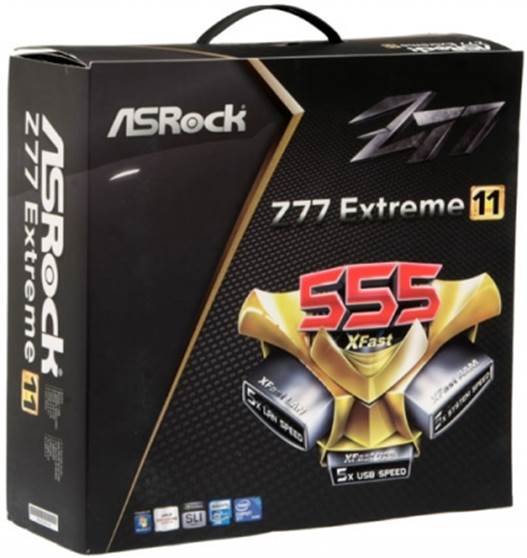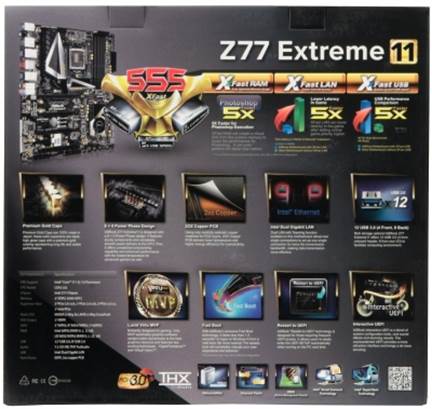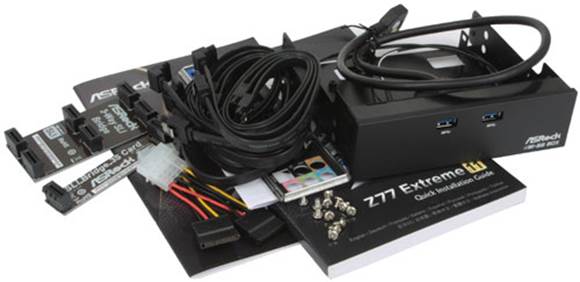This mainboard has unprecedentedly rich
functionality, including unique support for multiple SATA drives. Besides, it
has many other advantages and very few drawbacks with one of them standing out
among the others.
We have diligently reviewed many LGA1155
motherboards based on the Intel Z77 Express chipset, making up to 20 reviews about
several mainboards from six different makers. We’ve tested entry-level, mainstream
and flagship products, both regular and unique. We've discussed products
designed specifically for gaming or overclocking. We know that Z77-based motherboards
can only work with a single graphics card; a few models are better used with a
multi-GPU subsystem, and versatile products that work well whether you’ve got
one or more graphics cards installed. We know mainboards with integrated
wireless interfaces and expansion cards, with numerous USB 3.0 ports and
Thunderbolt. We seem to have to learn everything about them, so any new model
also seems to show only a certain combination of the features that we already
knew, but ASRock has managed to make us wonder with its unique Z77 Extreme11
which doesn’t look like anything we’ve tested so far.
As we noted in the previous review, Intel's
chipsets have remained the same throughout the years in terms of functionality.
It is only in series 7 that they have acquired USB 3.0 support but they still
only provide two SATA 6 Gbit/s and four SATA 3 Gbit/s ports, just like the
older series 6 chipsets. The original plan to
increase the number of high-speed interface for Intel X79 Express does not come
true, so it does not offer new capabilities. Actually, the
additional SATA ports have been implemented in the chip but remain blocked. We
know only one motherboard, the ECS X79R-AX model from Elitegroup, deploying
four SATA 6 Gbit/s ports via the additional chipset, but the manufacturer does
not guarantee the compatibility and stability. The Intel's cautious approach is
understandable, if we recall that the company had reliability issues after it
had introduced the new high-speed interface in its series 6 chipsets. Intel had
to quickly solve the problem by issuing revised chipsets, which involved time
and financial losses. But even though we understand Intel, we cannot like the
company’s current stance because it is we, end-users, who pay for Intel’s
caution. Motherboard manufacturers had to install additional controllers on
their products and make their product's design more complex as a consequence,
leading to an increase in product prices. Besides, AMD's new chipsets offer up
to 6 or even 8 SATA 6 Gbit/s ports that will eliminate the need of using extra
SATA controllers.
As I said, we have to admit that Intel's
chipsets are enough for a regular computer configuration which consists of one
or two HDDs (SSDs) and an optical drive. It's more complicated when you have multiple
drives and need to combine them into a RAID array. Thus, you must have three or
even more drives for your RAID to ensure greater efficiency and improved data
security because with two drives you can only increase performance at the
expense of reliability or ensure fault-tolerance at the expense of doubling the
cost of a single drive. If data security is a top priority, you can use a
dedicated multi-disk NAS, but it's not the best choice when you need high
speed. The built-in SATA controllers that the manufacturer
originally installed on their mainboard can’t solve our problems with only two
additional SATA 6 Gbit/s ports, and you have to find an expansion card with at
least four port. The ASUS P8Z77-V Premium is an exception because
it has a 4-port Marvell 88SE9230 controller. And it was the only model with
enhanced SATA capabilities before the release of the ASRock Z77 Extreme11.
So, what makes the ASRock mainboard really
special and unique? Basically it offers an 8 (!) port SAS2/SATA3 (6 Gbit/s)
controller - LSI SAS2308. It really is an unmatched feature, but simply
installing the chip on the mainboard isn’t enough. To ensure high bandwidth,
the controller used PCI Express while the Intel Z77 Express 3.0 only provides
PCI Express 2.0 lanes, and even the number of these lanes is limited. PCI
Express 3.0 is only supported by the CPU for discrete graphics card and it has
no extended or unnecessary PCIe 3.0 lanes, either. Therefore, integrating LSI
controller creates some clever technical solutions to ensure new advanced
features will not cause any restriction to the other features. In this review,
we intend to let you know the ASRock's innovative approach helps them come up
with an overall very successful product. Of course we also mention the other
features of the product.
Packaging and Accessories
The product box is designed in ASRock’s
traditional style. It has a carry handle and the front flap covers a large
see-through window which you can take a look at the mainboard.

The
product box is designed in ASRock’s traditional style.
A photo, features and specifications of the
Z77 Extreme11 are printed on the flap and on the back of the box.

Features
and specifications are printed on the flap and on the back of the box
Although the box is designed in the
standard way, its size is greater than usual. First, the mainboard itself is of
the E-ATX size. Its length of 305 mm complies with the ATX form-factor but its
width has been increased to 267mm. The board is protected by a soft foam frame
which also makes the packaging larger. There are two smaller boxes inside the
main box: for the Z77 Extreme11 itself and for its accessories:

Accessories
·
Eight Serial ATA cables with metal connector
locks, half with L-shaped locks and another half with straight ones;
·
Two power adapters for SATA devices;
·
A hard bridge for 2-Way NVidia SLI graphics
configurations;
·
A hard bridge for 3-Way NVidia SLI graphics
configurations;
·
ASRock Wi-SB Box module with two antennas, two
USB 3.0 ports, two slots for 2.5” drives and a set of retention screws;
·
I/O Shield for the back panel;
·
A brochure about the functionality of mainboard
BIOS and accompanying software;
·
User manual in multiple languages;
·
DVD disk with software and drivers.